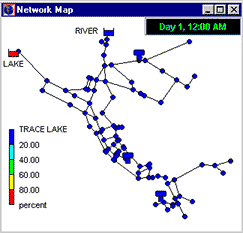Research Topic
| |||||||||
Introduction
Threat Ensemble Vulnerability Assessment Research Program
A collaborative, interdisciplinary group of scientists from the U.S. Environmental Protection Agency (EPA), the University of Cincinnati, Sandia National Laboratories, and Argonne National Laboratory comprise the TEVA research program. The American Water Works Association (AWWA) invited these scientists to partner with a group of its member utilities. The combined organization, referred to as the TEVA Users Group, ensures that TEVA products are relevant to the water community, pilot-tested on real water utility data, and readily available to users.
See Also
Research Highlights
- Previous TEVA Research Highlight
- Research Highlight: Threat Ensemble Vulnerability Assessment: Tucson Water Study
Reports and Papers
You will need the free Adobe Reader to view some of the files on this page.
See EPA's PDF page to learn more.
Sensor Placement
Sensor Placement for Contamination Warning Systems
A major focus of the TEVA research program has been on developing software tools to assist water utilities in determining the best location for sensors (e.g., water quality monitors) within water distribution systems. There are many considerations in locating sensors, including physical requirements (e.g., ease of access for maintenance, power, sewage), design objectives (e.g., public health protection, spatial coverage, detection time), and costs.
TEVA’s sensor placement optimization tool (SPOT) enables water utilities to determine and evaluate sensor placement. TEVA-SPOT requires specific information from the utility and allows users to select design objectives and compare and contrast the benefits of different sensor placements. TEVA-SPOT has been pilot-tested on many TEVA Users Group partner utilities and will be available for wider use in 2008.
See Also
Research Highlights
- Research Highlight: Award Nominated Program - EPA Recognized for Research on Reducing Risks to Drinking Water Systems
- Research Highlight: Threat Ensemble Vulnerability Assessment: Sensor Placement Software
Reports and Papers
- US Environmental Protection Agency Uses Operations Research to Reduce Contamination Risks in Drinking Water
January 2009
- Importance of Exposure Model in Estimating Impacts When a Water Distribution System Is Contaminated
September 2008
- Risk Reduction and Sensor Network Design (PDF) (11 pp, 110 KB) September 2008
- SPOT: A Sensor Placement Optimization Toolkit for Drinking Water Contamination Warning System Design (PDF) (12 pp, 59 KB)
- Model for Estimating Acute Health Impacts from Consumption of Contaminated Drinking Water (PDF) (7 pp, 453 KB)
- Sensor Placement in Municipal Water Networks (PDF) (14 pp, 236 KB)
- Sensor Placement in Municipal Water Networks with Temporal Integer Programming Models (PDF) (27 pp, 214 KB)
- A Comparison of Physical Sampling and Real-Time Monitoring Strategies for Designing a Contamination Warning System for Drinking Water Distribution Systems
You will need the free Adobe Reader to view some of the files on this page.
See EPA's PDF page to learn more.
Event Detection
Detection of Drinking Water Contamination Event
Given the current state of sensor technologies and the interest in better understanding water quality in distribution systems, many water utilities have been installing water quality sensors as part of a contamination warning system. Researchers have shown that in the presence of contaminants, water quality sensors are able to detect changes in free chlorine, total organic carbon (TOC), oxygen reduction potential (ORP), specific conductance, and other parameters.
Data analysis tools are needed to differentiate between normal changes in water quality (i.e., daily, seasonal, or operational fluctuations) and changes that may indicate a contamination event. The TEVA research program has developed CANARY, an event detection tool, that reads data from water quality sensors in real time and predicts whether the recorded water quality changes are actual contamination events. This data analysis tool is being pilot-tested and evaluated through the TEVA research program and is expected to be available for wider use later in 2007.
See Also
Research Highlights
Reports and Papers
- Online Water Quality Parameters as Indicators of Distribution System Contamination (PDF) (31 pp, 227 KB)
- Safeguarding the Security of Public Water Supplies Using Early Warning Systems: A Brief Review
Tools and Applications
- CANARY User's Manual Version 4.1 (PDF) (56 pp, 1.59 MB) (EPA/600/R-08/040A) March 2009. To find out more about the CANARY software and documentation, please contact Regan Murray, (513) 569-7031.
You will need the free Adobe Reader to view some of the files on this page.
See EPA's PDF page to learn more.
EPANET
EPANET Extensions
EPANET is a publicly available software package developed by EPA’s National Risk Management Research Laboratory and is available as a free download. EPANET estimates flow and water quality in pressurized pipe networks for water utility distribution systems.
The TEVA research program is developing several extensions to EPANET—software packages that work in conjunction with the existing EPANET and extend its capabilities. EPANET-MSX (a Multi-Species eXtension of EPANET) is a software package for modeling chemical and biological reactions in drinking water distribution systems. Other extensions under development include EPANET-DPX (Distributed Processor eXtension), EPANET-MCX (Monte Carlo eXtension), and EPANET-RTX (Real-Time eXtension). As information becomes available on these extensions, it will be posted on this Web site.
See Also
Research Highlights
Reports and Papers
- Using TEVA to Assess Impact of Model Skeletonization on Contaminant Consequence Assessment and Sensor Placement Design (PDF) (18 pp, 218 KB)
- Modeling Reaction and Transport of Multiple Species in Water Distribution Systems
Tools and Applications
- EPANET-MSX Software and Documentation (ZIP) Updated 5/7/08 (52 files, 837 KB)
You will need the free Adobe Reader to view some of the files on this page.
See EPA's PDF page to learn more.
Response
Other Modeling Studies
The TEVA research program relies on water utility distribution models (e.g., EPANET) as input for many of its tools. Therefore, research is also being conducted to better understand the accuracy of these models and to improve their general capabilities. For example, many water utility distribution models do not include every pipe in their system. The model is a “skeleton” of the full system. The TEVA research program has been investigating the impacts of skeletonization on sensor placement. Other areas being evaluated include the uncertainty in population estimates and demand patterns, along with the variability in operational patterns and consumption patterns.
See Also
Reports and Papers
You will need the free Adobe Reader to view some of the files on this page.
See EPA's PDF page to learn more.
![[logo] US EPA](https://webarchive.library.unt.edu/eot2008/20090508231549im_/http://www.epa.gov/epafiles/images/logo_epaseal.gif)

